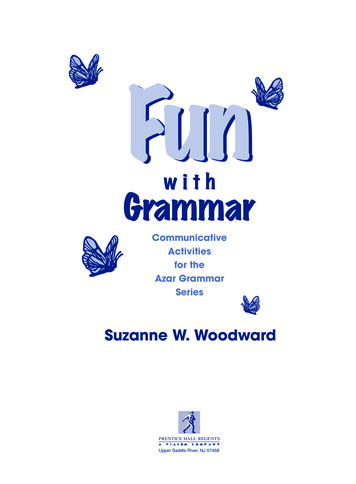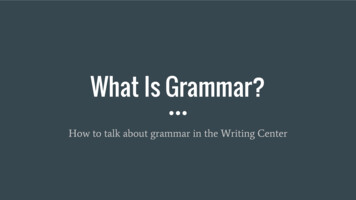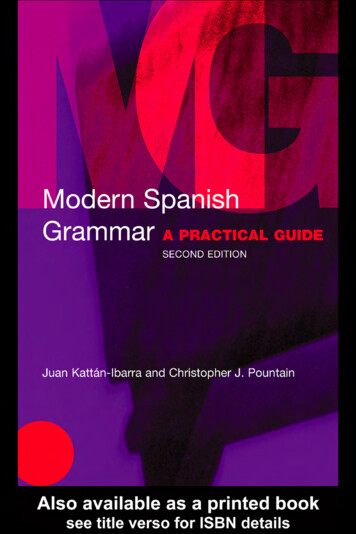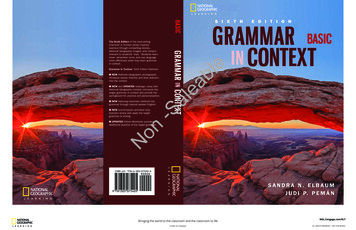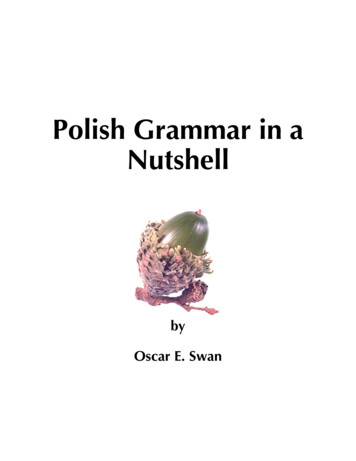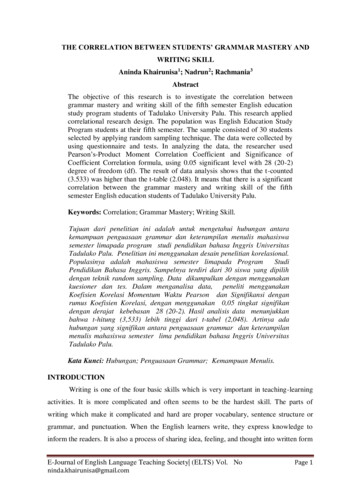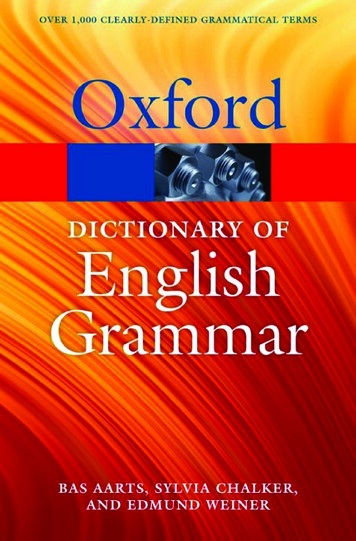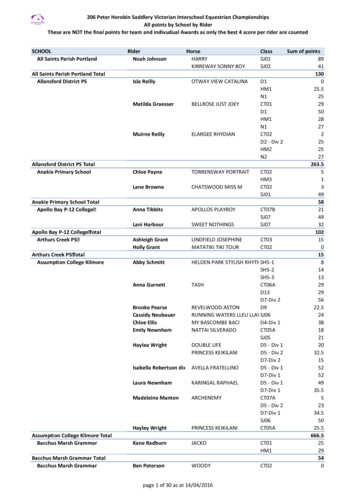
Transcription
언어연구 , 제25권 제2호(2008), 125-137Book ReviewA Note on the Grammar Book:An ESL / EFL Teacher’s Course*Chan Chung(Dongseo University)Chung, Chan. 2008. A Note on the Grammar Book: An ESL / EFL Teacher’s Course.Linguistic Research 25(2), 125-137. Although Celce-Murcia and Larson-Freeman (1999)(CL hereafter) is an excellent comprehensive textbook for the students in an ESL / EFLteacher’s course, it has some drawbacks. This review examines what they are and exploresbetter ways to present the relevant issues. First, CL do not clearly distinguish grammaticalfunctions from grammatical categories. The lack of this distinction causes confusion andinconsistency when PS rules are considered. Second, CL’s treatment of the determinerssuch as possessives, partitives, and phrasal quantifiers is too simplified and may leadto a wrong grammaticality prediction. Third, a discussion seems needed regarding theconnectivity in the relative clause constructions, which helps to choose an appropriaterelativizer. Fourth, a caution needs to be addressed on verbs’ subcategorization frames,many of which are not semantically predictable. Problems in the coordination constructionsare also illustrated. (Dongseo University)Keywords ESL / EFL, grammatical functions, determiners, connectivity, subcategorization,coordination1. IntroductionThe Grammar Book: An ESL / EFL Teacher’s Course (Celce-Murcia and Larson-Freeman1999, CL hereafter) is one of the best-known comprehensive textbooks for ESL / EFLteachers. It covers almost all the major constructions in English with linguistics-basedanalyses. One of its merits arises from the three-dimensional account of eachconstruction: the form, meaning, and use. While most of the other ESL / EFL teacher’stextbooks tend to cover only the form and the meaning, it extends the account to the* I would like to thank Ann Wennerstrom for letting me sit in her class at the University ofWashington and have opportunities of discussing the issues presented in this paper with her andother class participants. My thanks also go to the anonymous reviewers for their helpful commentsand suggestions. Of course, all remaining errors are solely mine.
126 Chan Chunguse dimension mainly based on the corpus analysis. Moreover, teaching suggestions ineach chapter are also very useful. Even though it has such merits, it seems to havesome issues and drawbacks. These defects arise from two factors: one is the mixed useof grammatical categories and grammatical functions, and the other arises fromneglection or misrepresentation of some important issues in several constructions suchas the noun phrase structures, relative clauses, subcategorization frames of verbs, andcoordination structures. The main goal of this review is to discuss those issues and toexplore better teaching alternatives from linguistic and pedagogical perspectives.The organization of this review is as follows. Section 2 considers the problemscaused by the lack of distinction between grammatical functions and grammaticalcategories. Section 3 examines problems arising from the analysis of noun phrases,especially focusing on the treatment of determiners. Section 4 examines theconnectivity in relative clauses. Section 5 considers the need of presenting verbs’subcategorization frames. Section 6 discusses the coordination constructions. Section 7offers a summary and conclusion.2. Grammatical Categories vs. Grammatical FunctionsIn chapter 5 of CL, confusion seems to arise from the description of the phrasestructure rules due to the lack of clear distinction between grammatical categories(parts of speech) and grammatical functions. For example, the terminologies such asthe predicate (PRED) or the subject (SUBJ) traditionally represent grammaticalfunctions, whereas the ones such as the noun phrase (NP) or verb phrase (VP)represent grammatical categories. A problem with the rule system given in CL is thatthe category names and function names are all mixed up:(1) a. S SUBJ PREDb. SUBJ NPc. PRED AUX VP (Advl)n (CL: 103)Categories and functions are both used as primitive notions in most syntactictheories, but they are distinguished to represent different syntactic levels. That is, acategory is a more superficial level of representation and can be defined in terms ofa form or a position in a sentence. However, a grammatical function is a more abstract
A Note on the Grammar Book : An ESL / EFL Teacher’s Course 127representation in that it represents a more meaning-oriented entity-thematic roles in amore technical term.The lack of this distinction causes confusion especially when the case is consideredwhere the same functional role is played by several different grammatical categories.For example, students are confused about how the possessive NPs such as the king ofEngland’s in (2a) and the possessive pronoun such as his in (2b) should be treated inthe CL:(2) a. [the king of England]’s crownb. [his] crownSince they look like a genuine noun (phrase), many students without syntacticbackground are confused when they are told that the elements should be considered asa determiner (or a specifier in technical terms). However, if we think two differentdescriptive levels with the functional level and the category level, examples in (2) areno longer confusing. That is, at the level of category, the king of England’s is a nounphrase and his is a personal pronoun. However, at the functional level, both functionas a determiner. Another merit of this dichotomy is that we can account for why nounphrases in (3) are ungrammatical, based on a simple restriction on the number ofdeterminers in an English noun phrase (Börjars and Burridge 2000: 191). Therestriction can be stated as follows in terms of CL: a noun cannot be specified by morethan one core determiner.1)(3) a.*the his bookb.*the Mary’s bookThat is, the noun book here is specified by two core determiners-an article and apossessive pronoun, and it leads to the ungrammaticality.Examples with a similar problem are (4):(4) a. We are open [NP Saturdays]b. We are open [PreP on alternate Sundays].c. We meet [AdvP very often].1) According to CL, the core determiner includes possessives, articles, demonstratives, and somequantifiers such as every, some, etc. (CL: 335).
128 Chan ChungAccording to CL, the NP, PreP, and AdvP in the brackets are all introduced by theAdvl given in (1c), and thus it is not easy to explain why they all show differentsyntactic behaviors: Saturdays are an NP since it carries a plural morpheme; onalternate Sundays is a PreP since it is headed by a preposition on; and very often isan adverb phrase since it is modified by a intensifier very. If we assume the differentlevels, however, examples in (4) are no longer problem since it is only at thefunctional level that they have the same role. All the differences occur at the categorylevel.Another problem caused by CL’s system is that it raises inconsistencies. Consider theexample in (5):(5) Children rely [PreP on parents] [PreP in their childhood].In general, the second PreP in their childhood is considered as an adverbial, whilethe first PreP on parents as a complement. Then, according to CL, on parents isintroduced by the PreP in the rule “VP V (NP)2 (PreP)” while in their childhood isintroduced by the Advl in rule (1c) first, and then by the PreP in the other rule “Advl PreP.” Then a question often raised by students is why on parents shouldn’t beintroduced by another element such as the Compl (Complement) first and then by theother rule “Compl PreP,” which makes the whole system very complicated. In otherwords, the PS rule system given in CL fails to be consistent since the function namesand category names are used without clear distinctions. If the distinction is introduced,(5) is no longer confusing. They are both PrePs at the category level, but they havedifferent functions, a complement vs. an adverbial.The ones that are usually considered as parts of speech are N(P), V(P), A(P),Prep(P), S, S’, ADV, AUX, etc., while the ones considered as function names areSUBJ, PRED, Adverbial (adjunct or modifier), complement, specifier, etc.2) In order tosimply distinguish the categories from and functions, a separate label needs to beintroduced into the tree diagram. For example, a functional specification may berepresented on a branch to show the specific function carried by the corresponding2) CL also treat the ones related to morphological forms like past, pl, perf, prog, etc. as independentsyntactic elements. They may be considered as functional categories in Chomskyan-style theories(e.g., Pollock 1989). However, they are all considered not as independent syntactic categories butas grammatical features in other theories like Generalized Phrase Structure Grammar (Gazdar et al.1985), Head-Driven Phrase Structure Grammar (Pollard and Sag 1994), and Lexical FunctionalGrammar (Bresnan 2001).
A Note on the Grammar Book : An ESL / EFL Teacher’s Course 129category at each node:(6)SSUBJPREDNPVPSPECNPHEADNADVLVPPrepPCOMPAUX VPThe young lady’s sonwillgoPrepPto collegein the futureThe structure (6) shows the following: the category of the young lady’s is an NPwhile its function is a specifier (or determiner); The category of to college and in thefuture is the same PreP while they have different functions, a complement and anadverbial, respectively. This approach incorporates linguistic concepts in a better wayand avoids unnecessary confusion.3. Noun Phrase StructuresSeveral problems arise from CL’s analysis of noun phrases, especially from theanalysis of determiners. This section examines what the problems are and explores abetter analysis under CL’s framework.3.1 PossessivesThe NP structure given by CL has two determiners that are sisters to the head nounas shown in (7):
130 Chan Chung(7)NPdetdetNmyneighbor’sdaughter-in-law(CL: 303)This structure has two problems. Semantically, the determiner my should specifyneighbor not daughter-in-law. However, (7) does not represent it correctly since heremy specifies daughter-in-law. The other problem is related to a general constraint onthe distribution of core determiners in English that are mentioned already: a nouncannot be specified by more than one core determiner. The NPs in (8) are allungrammatical since they violate this rule:(8) a.*her Mary’s book / *Mary’s her bookb.*the his book / *his the bookc.*this his book / *his this bookIf we allow the structure in (7), then it is hard to keep the generalization and toaccount for the ungrammaticality in (8). In order to avoid these two problems, structure(7) should be reanalyzed as in s shown in (2a), the possessive marker -’s attaches to a whole noun phrase inEnglish. We may use a functional category name for the -’s node, namely ’Poss’, asone of the functional categories.3)3) More precisely speaking, the English possessive is considered here as a kind of clitic, which is anindependent word at the syntactic level, but a bound word at the phonological level. (See Pollard
A Note on the Grammar Book : An ESL / EFL Teacher’s Course 1313.2 PartitivesAnother problem in CL arises from the discussion of partitives (CL: 326-328). CLstate the following: “When the partitive noun is part of the subject, the verb agreeswith it. If the partitive noun is singular, the verb is singular. If the partitive noun isplural, the verb is also plural (CL: 326).” However, this statement oversimplifies thefact in English and may confuse the ESL learners. We need at least two types of thepartitives regarding the subject-verb agreement. One is the type where the number ofthe whole NP is determined by the partitive noun itself as mentioned by CL:(10) a. A mountain of dirty laundry was / *were piled up after our vacation.b. Mountains of dirty laundry were / *was piled up after our vacation.(adapted from CL: 326)The other partitive type concerns the determination of the number of the whole NPby the noun occurring after the preposition, not by the partitive noun:(11) a. Some of the apple is / *are rotten.b. Some of the apples are / *is rotten.Partitives such as most of, all of, half of, and the rest of belong to the latter type.3.3 Phrasal DeterminersThe determiner system proposed by CL may need revision. Following Quirk et al.(1985), CL assume three different types of determiners: predeterminers (e.g., all in allthe books), core determiners (the in all the books), and postdeterminers (e.g., many inthe many books) (CL: 335). CL state that some phrasal quantifiers such as another (thecombination of an other), a few, a little, a great deal of, and a number of belong tothe postdeterminers, entailing they can occur after a core determiner. However, thisclassification is problematic since such phrasal quantifiers never occur after a coredeterminer such as his. Some of them can rather occur before a core determiner:and Sag 1994: 54.)
132 Chan Chung(12) a. *[his] [another] bookb. *[his] [a number of] booksc. *[his] [a lot of] booksd. *[his] [a great deal of] books(13) a. *[another] [his] bookb. [a number of] [his] booksc. [a lot of] [his] booksd. [a great deal of] [his] booksThe contrast shown in (12) and (13) suggests that if these phrasal quantifiers shouldbe treated as determiners, they need to belong to core determiners or to predeterminers,rather than to postdeterminers.4. Connectivity in the Relative Clause ConstructionsChapters 28 and 29 in CL discuss the relative clause constructions. Here animportant issue is unclearly addressed. The issue is the connectivity among therelativizer (relative pronoun or relative proadverb), its gap, and its antecedent.4) Forexample, the grammatical contrasts in the examples in (14) are often confusing to theESL learners. Why should we use that or which in a certain case while where in theother case?(14) a. This is the place that / which I like.b.*This is the place where I like.c. This is the place where I first met my wife.d.*This is the place that / which I first met my wife.It is generally assumed that a syntactic connectivity should exist between arelativizer and its gap since the relativizer can be analyzed to be extracted out of thegap position, which is represented by the solid line in (15) below. Thus the relativizerand its gap should have the same grammatical category and the same case.4) See Jacobson (1984) for more detailed and theoretical issues regarding the syntactic connectivitydiscussion.
A Note on the Grammar Book : An ESL / EFL Teacher’s Course 133(15) a. This is [the place] [that / which [I like ].b. This is [the place] [where [I first met my wife ].In (15a), the relativizer and its gap play the role of the NP object of the verb withinthe relative clause. It entails that the relativizer should also be a noun, and hence therelative ‘pronoun.’ However, in (15b), the relativizer and its gap play the role of anadverbial and thus the relativizer should also be an adverb, and hence a relative‘proadverb’.In contrast, the relationship between the relativizer and its antecedent has onlysemantic connectivity (Pollard and Sag 1994: 213), which is represented by the dottedline in (15). In (15a), the relative pronoun refers to a non-human being, namely aplace, and thus should be that or which not who or whom. In (15b), however, therelative proadverb refers to a place and thus should be where not when or why.The discussion on connectivity helps the ESL learners avoid confusion regarding theselection of a relative pronoun’s case form. The accusative or nominative case isdetermined by syntactic connectivity, and thus the relationship between the relativepronoun and its gap need to be considered, not the relationship between the relativepronoun and its antecedent. As shown in (16) below, if the gap is an object of a verbor preposition, the relative pronoun should be accusative, who or whom.5) If the gapis the subject, the relative pronoun should be nominative, who but not whom.(16) a. I saw [the woman] [who / whom [I met in Seattle]].b. I saw [the woman] [who / *whom [ lived in Seattle]].Here the determination of the case has nothing to do with the role of the antecedentNP, the woman, since the relative pronoun and its antecedent have just a semantic5) Here the relativizer who is assumed to carry either nominative or accusative case.
134 Chan Chungconnectivity. In (16b), for example, the woman is an object of the verb saw, but therelative pronoun should be nominative.5. SubcategorizationThe notion of subcategorization is another important issue not clearly addressed inCL. As observed by Hubbard and Hix (1988), the subcategorization frame of a verbis crucial for ESL / EFL writers at the advanced or intermediate stage. Due to theinfluence of school grammar, many ESL learners tend to think that verbs are classifiedinto five types depending on their complement(s), a verb without an object, a verb withone object, a verb with two objects, a verb with a subject complement, and a verb withone object and one object complement. Such a classification or generalization may helpESL learners read or understand already completed or given sentences. However, whenthey write or form a sentence in English, much more specific information on a verb’ssubcategorization is required. At least one section should discuss the difficulty ofsemantically guessing what should come after a verb to complete a sentence. A fewexamples from Gazdar et al. (1985: 32) highlight such difficulties:(17) a. The beast ate the meat (ravenously).b. The beat devoured the meat.c. The beast ate (ravenously).d.*The beast devoured.(18) a. Aren’t you even going to try to solve it?b. Aren’t you even going to attempt to solve it?c. Aren’t you even going to try?d.*Aren’t you even going to attempt?Here the meaning of the verbs eat and devour in (17), and try and attempt in (18)are “(near) synonymy,” but they have very different subcategorization frames as shownby the contrast in (c,d) sentences. The complements of eat and try are optional, butthose of devour and attempt are not. The best way to have ESL learners avoidmistakes involving the subcategorization seems to make them refer to a dictionarywhen they are not sure what the complement is.
A Note on the Grammar Book : An ESL / EFL Teacher’s Course 1356. CoordinationCL assume that only the identical category can be conjoined: “we find difficultiesconjoining two constituents that are not of the same type: *bread and strong, *very bigand hide, *The police saw nothing unusual and effectively” (CL: 462). However, thisstatement oversimplifies the fact in English since different grammatical categories canbe conjoined especially when the verb is a linking verb, as shown in (19) and (20):(19) a. Pat is either [AP stupid] or [NP a liar].b. Pat is [AP healthy] and [PrepP of sound mind].c. Sandy is either [NP a lunatic] or [PrepP under the influence of drugs].d. I am [VP hoping to get an invitation] and [AP optimistic about any chances].(Sag et al. 1985)(20) Pat has become [NP a banker] and [AP very conservative]. (Sag et al. 1985)A different type of unlike-category coordination construction is also illustrated in(21), where different categories such as AdvP, PreP, and NP are conjoined, allfunctioning as adverbials:(21) a. We walked [AdvP slowly] and [PreP with great care].b. They wanted to leave [NP tomorrow] or [PreP on Tuesday].c. We are open [NP Saturdays], [NP any national holiday], and [PreP on alternateSundays]. Peterson (2004)Another minor problem in CL is the PS rule for the coordination structure in (22)(CL: 462) since it allows only two or three conjuncts:(22) X X Conj X (Conj X)However, the number of conjuncts in the coordination construction can be infinite inprinciple: A and B and C and D and E, and so forth. Therefore, the rule should berestated as the one in (23), where the last conjunct is annotated with the Kleene staroperation, *. It represents the annotated conjunct can be iterated zero, one, or morethan one up to the infinite number of times.(23) X X Conj X (Conj X)*
136 Chan Chung7. ConclusionCL is an excellent comprehensive textbook for the students in an ESL / EFLteacher’s course. However, it has some issues and drawbacks that should be consideredwhen the teachers or students use the book. First, note that CL do not clearly makethe traditional distinction between grammatical categories and grammatical functions.The lack of this distinction seems to cause confusion when students deal with theelements that several different grammatical categories play the same role, such as aspecifier (or determiner) and an adverbial. Such a system also brings aboutinconsistency in dealing with PS rules. Second, their treatment of the NP structureseems to be too simplified, and a special caution seems needed regarding possessives,partitives, and phrasal quantifiers. Third, a more explanation is needed for theconnectivity in the relative clause constructions, which helps students choose anappropriate relativizer. Fourth, a caution needs to be addressed regarding thesubcategorization frames of verbs, many of which are semantically unpredictable andbring about difficulties in writing. Problems in the analysis of the coordinationconstructions are also discussed.
A Note on the Grammar Book : An ESL / EFL Teacher’s Course 137ReferencesBresnan, Joan. 2001. Lexical-Functional Syntax. Oxford: Blackwell.Börjars, Kersti and Kate Burridge. 2000. Introducing English Grammar. Hodder Arnold.Celce-Murcia Marianne and Diane Larson-Freeman. 1999. The Grammar Book: An ESL / EFLTeacher’s Course, Second edition. Heinle & Heinle Publishers.Gazdar, Gerald, Ewan Klein, Geoffrey Pullum, and Ivan Sag. 1985. Generalized Phrase StructureGrammar. Oxford: Basail Blackwell.Hubbard, Philip and Donna Hix. 1988. Where vocabulary meets grammar: verb subcategorizationerrors in ESL writers. The CATESOL Journal, November. 89-100.Jacobson, Pauline. 1984. Connectivity in phrase structure grammar. Natural Language andLinguistic Theory 1, pp. 535-581.Peterson, Peter. 2004. Coordination: consequences of a lexical-functional account. NaturalLanguage and Linguistic Theory 22, pp.643-679.Pollard, Carl and Ivan Sag. 1994. Head-Driven Phrase Structure Grammar. Stanford: CSLI andChicago: University of Chicago Press.Pollock, Jean-Yves. 1989. Verb-movement, Universal Grammar, and the structure of IP. LinguisticInquiry 20, pp.365-424.Quirk, Randoph, Sidney Greenbaum, Geoffrey Leech, and Jan Svartvik. 1985. A ComprehensiveGrammar of the English Language. London and New York: Longman.Sag, Ivan., Gerald Gazdar, Thomas Wasow, and Steven Weisler. 1985. Coordination and how todistinguish categories, Natural Language and Linguistic Theory 3, pp.117-171.Chung, ChanDongseo UniversityChurye-2-Dong Sasang-GuBusan 617-716, KoreaE-mail: cchung@dongseo.ac.krReceived:2008. 05. 08Revised : 2008. 05. 29Accepted:2008. 06. 12
Book Review A Note on the Grammar Book: An ESL/EFL Teacher’s Course* Chan Chung (Dongseo University) Chung, Chan. 2008. A Note on the Grammar Book: An ESL / EFL Teacher’s Course. Linguistic Research 25(2), 125-137. Although Celce-Murcia and Larson-Freeman (1999) (CL hereafter) is an ex


